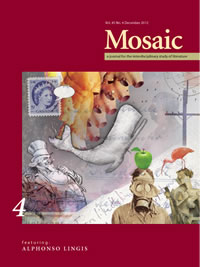Issue 45.4
Overview

General Issue
Published: December 2012
View the issue introduction or see the issue summary and contents below.
10 essays, totalling 192 pages
$21.95 CAD
This Mosaic “Feature Issue” headlines the remarkable work of Alphonso Lingis, opening with a public lecture delivered by him at the University of Manitoba in October, 2012, including an interview/conversation with Lingis, and an original essay-reflection written by him. The issue is made all the more special by the seven additional essays it includes, essays that range widely, for instance through the work of Magritte, McEwan, Melville, Laurence, Hitchcock, and Dos Passos.
Crossings: A Discussion with Alphonso Lingis[no author] On 3 October 2012, Alphonso Lingis, a Distinguished Visiting Lecturer at the University of Manitoba, participated in an open three-hour interview with Mosaic and a number of invited student and faculty participants. The following is a condensed transcription of that memorable conversation. | |
One’s Own VoiceAlphonso Lingis On 2 October 2012, Alphonso Lingis delivered the following as a Distinguished Visiting Lecturer public address held at the University of Manitoba and initiated by Mosaic. We are pleased and honoured to publish the address in this Lingis feature issue. | |
The Weight of the WorldAlphonso Lingis The following series of reflections are suggestive of the sense in which phenomenology, for Lingis, is personal and poetic, a mode of illuminating the world, its people and its things, bodies living and dead, that he encounters, and is moved by, in his journeys to numerous places. | |
John Dos Passos in the 1920s: The Development of a Modernist StyleDonald Pizer The essay discusses Dos Passos’s development of a modernist fictional style during the 1920s by describing its distinctive components in his major works of the decade and by seeking out Dos Passos’s sources for the experimental direction his writing was taking in the visual techniques of analytical and collage cubism and of film montage. | |
A Fantasy of One’s Own: Rooms in Hitchcock’s Vertigo and Baudelaire’s Prose TextsVlad Dima This essay explores connections between Alfred Hitchcock’s Vertigo and Charles Baudelaire’s prose texts. The main character of the film and the narrator of the prose texts are both confined emotionally in their own dreams and fantasies, but also physically, in a multitude of restricting, prison-like rooms that mirror the dynamic of the unconscious. | |
Magritte’s La clef de verre and Hammett’s The Glass Key: An Interarts DialogueBen Stoltzfus Magritte’s painting, La clef de verre, borrows its title from Hammett’s novel The Glass Key. The rock in the picture, the key in the title, and the plot of the whodunit generate an interarts dialogue, an ekphrasis, from which Magritte paints thought—a visible poetry that mediates between the stasis of the image and the dynamism of words. | |
Purloined Letters in Ian McEwan’s AtonementHeta Pyrhönen This essay probes the intertexts of Atonement, in particular the links it shares with E.A. Poe’s “The Purloined Letter.” By drawing on the psychoanalytical context of Lacan’s “Seminar on ‘The Purloined Letter,’” the essay shows how the theft of a letter affects the novel’s protagonist-narrator’s writing, leading to a compulsive attempt to hide her shame. | |
Récits de voyageuses en Afrique du Sud et conquête du corps victorienLudmila Ommundsen Pessoa Cette étude s’intéressera, sur fond d’impérialisme britannique et de montée du mouvement féministe, à la corporalité des voyageuses victoriennes dans leur récit d’un voyage en Afrique du Sud entre convenance et impudence, profane et sacré, à la recherche d’une Surfemme dans un ailleurs symbolique aux contours carnavalesques. | |
Irreconcilable Differences: Voices, Trauma, and Melville’s Moby-DickTara Fee This essay argues that Ishmael’s implausible narration in Moby-Dick (with its evident concealments, inventions, and fantasies) results from his status as a traumatized survivor and that through his incoherence, the novel insists that accounts of trauma cannot be subjected to the totalizing schemata of narrative aesthetics or therapeutic teleology. | |
Margaret Laurence: The Woman and the MasksNora Foster Stovel Margaret Laurence employs masks, both literal and figurative, in her fiction and nonfiction, both African and Canadian, to convey her characters’ personae. The connections between her life and work suggest that her Canadian heroines are facets, or masks, of Laurence’s self. |